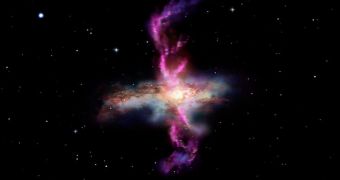Data collected using the most advanced space telescope in the world are indicating that some galaxies may develop storms that are so powerful that they wipe out the gas used for forming new stars.
These storm-like events generate a huge outflow of hydrogen gas out of stellar nurseries, and then out of galaxies, leaving the space structures incapable of producing any blue stars. This growth control mechanism has not been evidenced before.
Astronomers first proposed that gaseous galactic outflows existed, but they could never prove the structures actually existed. Now, thanks to the European Space Agency's (ESA) Herschel Space Observatory, detecting such formations has become a breeze.
The structures that the telescope observed were streams of molecular hydrogen gas. The spacecraft saw them as they were leaving galaxies, and therefore depleting their internal reserves. Without gas, it is impossible to create new star.
Due to its complex instruments, Herschel was also able to calculate that the winds were traveling at speeds of up to 1000 kilometers per second. For comparison, the wind speeds recorded during the fastest hurricane on Earth are 10,000 lower.
“With Herschel, we now have the chance to really study what these outflows mean for galactic evolution,” explains the lead author of the new study, Eckhard Sturm. He is based at the Max Planck Institute for Extraterrestrial Physics, in Germany.
He and his group used Herschel to image a sample of 50 galaxies at various locations across the sky. The Photoconductor Array Camera and Spectrometer (PACS) instrument was the main tool used.
According to the MPI-EP team, the galaxies recording the most vigorous outflows lose an estimated 1,200 solar masses of gas each year. Depending on the size of the galaxy, this means that such a structure would lose its ability to form new stars in 1 to 100 million years.
Experts propose that these winds are caused by phenomena such as the explosion of old stars during supernova events. Another possible source is the emission of photons and radiations from new stars.
These radiations are known to be able to stir up the stellar nursery in which the new star formed. Experts say that this is one of the mechanisms proposed by experts trying to explain the formation of elliptical galaxies.
“By catching molecular outflows in the act, Herschel has finally yielded long-sought-after evidence that powerful processes with negative feedback do take place in galaxies and dramatically affect their evolution,” ESA Herschel project scientist Göran Pilbratt.

 14 DAY TRIAL //
14 DAY TRIAL //